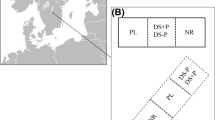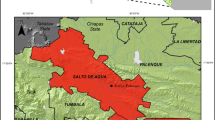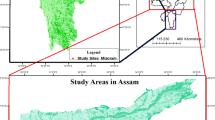Abstract
Establishing trees in pastures can have production and conservation benefits, but is complicated by the presence of livestock. The need to protect seedlings from livestock increases tree establishment costs, which in turn, can deter landowners from planting trees. Living fences are a ubiquitous feature of pasture landscapes in the tropics that could help protect newly planted trees by preventing livestock trampling and browsing. This study quantified the effectiveness of a living fence in protecting tree seedlings during the first 2 years after planting. The four native tree species evaluated were: Cedrela odorata L., Pachira quinata (Jacq.) W.S. Alverson, Samanea saman (Jacq.) Merr., and Tabebuia rosea (Bertol.) A. DC. Results show that the living fence provided protection from livestock except in cases where tree species were highly palatable as forage (i.e. P. quinata). Trees planted into the living fence generally had greater survival (62 vs. 28%), relative growth (10.3 times initial height vs. 5.8 times initial height), and final height (191 cm vs. 108 cm) compared to those planted in open pasture after 2 years. However, survival and growth of trees planted into the fence remained lower than that observed at a nearby plantation with no livestock, regular weeding and no living fences. This study indicates that use of living fences as a protective barrier could be an effective low-cost approach for establishing trees in tropical pasture landscapes.


Similar content being viewed by others
References
Arnold M, Dewees P (1998) Rethinking approaches to tree management by farmers. Nat Resour Perspect 26:1–9
Beetson TB, Taylor DW, Nester MR (1991) Effect of treeshelters on early growth of four Australian tree species. Aust For 54:60–65
Borel R, Romero F (1991) On-farm research in a silvopastoral project: a case study. Agrofor Syst 15:245–257. doi:10.1007/BF00120191
Budowski G (1993) The scope and potential of agroforestry in Central America. Agrofor Syst 23:121–132. doi:10.1007/BF00704910
Callaway RM (1995) Positive interactions among plants. Bot Rev 61:306–349. doi:10.1007/BF02912621
Craven D, Hall J, Verjans J-M (2008) Impacts of herbicide application and mechanical cleanings on growth and mortality of two timber species in Saccharum spontaneum grasslands of the panama canal watershed. Restoration Ecol (Published On-line)
Day RW, Quinn GP (1989) Comparisons of treatments after an analysis of variance in ecology. Ecol Monogr 59:433–463. doi:10.2307/1943075
Eason WR, Gill EK, Roberts JE (1996) Evaluation of anti-sheep tree-stem-protection products in silvopastoral agroforestry. Agrofor Syst 34:259–264. doi:10.1007/BF00046926
Harvey CA, Villanueva C, Villacis J et al (2005) Contribution of live fences to the ecological integrity of agricultural landscapes. Agric Ecosyst Environ 111:200–230. doi:10.1016/j.agee.2005.06.011
Holdridge LR (1967) Life zone ecology. Tropical Science Center, Costa Rica
Huxley PA (1987) Agroforestry experimentation: separating the wood from the trees? Agrofor Syst 5:251–275. doi:10.1007/BF00119125
Hyde WF, Amacher GS, Magrath W (1996) Deforestation and forest land use: theory, evidence, and policy implications. World Bank Res Obs 11:223–248
Jose S, Gillespie AR, Pallardy SG (2004) Interspecific interactions in temperate agroforestry. Agrofor Syst 61:237–255. doi:10.1023/B:AGFO.0000029002.85273.9b
Kaitho RJ, Umunna NN, Nsahlai IV et al (1996) Palatability of multipurpose tree species: effect of species and length of study on intake and relative palatability by sheep. Agrofor Syst 33:249–261. doi:10.1007/BF00055426
Ledec G (1992) New directions for livestock policy: an environmental perspective. In: Downing T, Hetch SB, Pearson HA et al (eds) Development or destruction: the conversion of tropical forest to pasture in Latin America. Westview Press, Colorado, pp 27–65
Lehmkuhler JW, Felton EED, Schmidt DA et al (2004) Tree protection methods during the silvopastoral-system establishment in Midwestern USA: cattle performance and tree damage. Agrofor Syst 59:35–42. doi:10.1023/A:1026184902984
León MC, Harvey CA (2006) Live fences and landscape connectivity in a neotropical agricultural landscape. Agrofor Syst 68:15–26. doi:10.1007/s10457-005-5831-5
Lewis CE (1980) Simulated cattle injury to planted slash pine: combinations of defoliation, browsing, and trampling. J Range Manage 33:340–345. doi:10.2307/3897879
Long AJ, Nair PKR (1999) Trees outside forests: agro-, community, and urban forestry. New For 17:145–174. doi:10.1023/A:1006523425548
Piotto D, Montagnini F, Ugalde L et al (2003) Performance of forest plantations in small and medium-sized farms in the Atlantic lowlands of Costa Rica. For Ecol Manage 175:195–204. doi:10.1016/S0378-1127(02)00127-5
Pitt MD, Newman RF, Youwe PL et al (1998) Using a grazing pressure index to predict cattle damage of regenerating tree seedlings. J Range Manage 51:417–422. doi:10.2307/4003326
SAS Institute (2004) Sas/stat 9.1 user’s guide. SAS Institute, Cary, N.C
Stokes ME, Davis CS, Koch GG (1995) Categorical data analysis using the sas system. SAS Institute Inc., Cary, NC
Stuth JW (1991) Foraging behavior. In: Heitschmidt RK, Stuth JW (eds) Grazing management: an ecological perspective. Timber Press, Portland, OR, p 259
Zahawi RA (2005) Establishment and growth of living fence species: an overlooked tool for the restoration of degraded areas in the tropics. Restor Ecol 13:92–102. doi:10.1111/j.1526-100X.2005.00011.x
Acknowledgments
A Natural Sciences and Engineering Research Council Canada Graduate Student Scholarship and the John G. Bene Fellowship in Community Forestry offered by the International Development Research Centre supported B. Love during this research. The Native Species Reforestation Project (PRORENA): Smithsonian Tropical Research Institute, Roosevelt Ave., Tupper Building–401, Balboa, Ancón, Panamá, República de Panamá, provided tree seedlings and comparative plantation data. We thank Shane Matias of Peace Corps Panama for his assistance during data collection, and Dr. Scott Chang of the University of Alberta together with 2 anonymous reviewers, for helpful suggestions during manuscript development.
Author information
Authors and Affiliations
Corresponding author
Rights and permissions
About this article
Cite this article
Love, B.E., Bork, E.W. & Spaner, D. Tree seedling establishment in living fences: a low-cost agroforestry management practice for the tropics. Agroforest Syst 77, 1–8 (2009). https://doi.org/10.1007/s10457-009-9244-8
Received:
Accepted:
Published:
Issue Date:
DOI: https://doi.org/10.1007/s10457-009-9244-8




